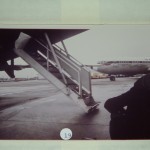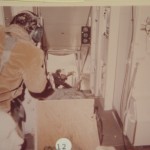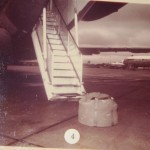Geoffrey Gray's Blog, page 10
July 5, 2011
The Aerial Test
Where did the hijacker's parachute land? Over the past four decades, this mystery is at the center of the many mysteries within the D.B. Cooper case. Originally, federal agents wanted to simulate the jump and strap up a parachute expert and have him bail out of the Northwest jet just like Cooper.
There were problems with that approach though. What if the expert got hurt? What if he impailed himself on a spear? Did they need the jumper anyway?
The solution the feds came up with was to simulate the simulation. Instead of using a parachutist, they concocted weights to match that of the hijacker and the ransom. Once in the air, military experts tested the aft-stairs to see if a jump was possible. It was, they concluded. Instead of a stormy gusty danger zone, the aft-stairs proved to be a sheilded perch above the great forests of the Pacific Northwest, certainly a doable place to make a jump.
Here is one of the military's parachutists testing the aft-stairs, and one of the testing weights.
June 5, 2011
Did D.B. Cooper leave a calling card?
After the hijacking, agents from the FBI and newspaper editors received countless letters from anonymous writers claiming credit for the hijacking. Some letters had a comic tone ("Yabba Dabba Do! Admit it, I've won! You've lost!") and others were braggy: "I have succeeded in pulling off one of the most successful, talked about crimes of today." One letter though had a different and depressed tone, almost suicidal, a condition that was consistent with many hijackers from the era. It reads:
I am no modern-day Robin Hood. Unfortunately I do have only 14 months to live. My life had been one of hate, turmoil, hunger, and more hate.
Check out the clip to the story, printed in the Los Angeles Times. The report also notes the letter came with a code, a mysterious sequence of letters and numbers: "7698QA2753." Any code crackers out there?
May 9, 2011
Wait, How Did It Happen Again?
 One question that comes up often: How does anyone jump out of a commercial airliner? Through the little windows by our seats? The front door? The answer is neither. Decades ago, Boeing designed their 727 mid-range jets with stairs in the very rear of the cabin. Aftstairs, they were called. The reason was airports. In the late 1960's, American cities were building bigger airports and expanding their runways to make room for the jumbo jet, or 747. In comparison, the smaller and more nimble 727 was used to accommodate smaller cities that had yet to build big airports and the aftstairs in the back were used to load passengers on the runway.
One question that comes up often: How does anyone jump out of a commercial airliner? Through the little windows by our seats? The front door? The answer is neither. Decades ago, Boeing designed their 727 mid-range jets with stairs in the very rear of the cabin. Aftstairs, they were called. The reason was airports. In the late 1960's, American cities were building bigger airports and expanding their runways to make room for the jumbo jet, or 747. In comparison, the smaller and more nimble 727 was used to accommodate smaller cities that had yet to build big airports and the aftstairs in the back were used to load passengers on the runway.
After Cooper's jump, federal agents learned the aftstairs had been used for another purpose. Through front groups, officials disclosed to the authorities hunting Cooper that the CIA, through front groups like Air America, had used the Boeing 727 and its aftstairs to drop cargo and parachutists in covert missions during Vietnam. Was Cooper an ex-rogue CIA agent involved with Air America or another black ops contractor? Here is a photo of what the aftstairs look like on Northwest N467US, the actual plane that was hijacked on November 24th, 1971.
What You Should Know, A Primer.
There are mysteries within the mysteries of the Cooper case. To understand the many levels, it's helpful to prepare and read up on the basics. But sleuthers beware: even the basic facts can become booby traps. The memories of what happened that night have been re-told so many times that certain information and ideas about the case have cemented into myths. One of the most comprehensive places to learn about what happened versus what was reported to have happened is n467us.com, a one-stop research website started by the talented Cooper sleuth named Wayne Walker who is known to most by his cyber handle, Sluggo. For a detailed primer, start there.
Welcome
Almost four years ago, I received a phone call that started all this. Skipp Porteous, a private detective I know, had received a tip over the transom about a suspect in one of the biggest manhunts and mysteries in the annals of American crime, the case of D.B. Cooper. It was a tip I followed and one that led to other tips, many others, and soon I was in a free fall down the sinkhole and into Cooperland.
The hunt to uncover the identity of D.B. (an inaccurate moniker, but more on that later) resulted in scores of interviews with passengers, stewardesses, witnesses, detectives, state troopers, federal agents, air traffic controllers, retired pilots, alleged CIA contractors and black ops conspirators, to name a few. The hunt took me to the mouth of an old gold mine in California, under a man hole cover in a hazelnut farm in Oregon, into a paleontologist's lab in the deserts of Arizona, and down into the basement archives of the FBI's field office in Seattle, among other places in nearly a dozen states. I've obtained and read hundreds of confidential case files. I've rented plenty of cars and been on many flights. The result is SKYJACK, my first book, to be published later this summer, and this website, also my first, which is designed to be a kind of clubhouse for Cooper sleuthing as the fortieth anniversary of the daring parachute hijack approaches late this November.
Leading up to the fortieth anniversary, I will be making regular posts and uploading material about the case. Also you can contact me with any questions and curiosities here. A warning: Be prepared. Once you get into the Cooper case, it's hard to get out. As one Cooper sleuth once told a reporter, after stomping around the forests of southwest Washington for twenty two years, "I know there's something out here. There has to be."
April 6, 2011
Mystery of the Raleigh Filter Tip Cigarette Butts
One of the most specific clues in the Cooper case were eight filter tipped cigarrette butts found in the ashtray of row 18 on the hijacked plane. At the time, Raleigh was a coupon cigarette, meaning that if you smoked enough of them, you qualified for free packs and merchandise. The FBI went so far as to inquire into the 6 million Raleigh coupon smokers. Was Dan Cooper among them? Or, as some suspected, did Dan Cooper smoke as a way to throw off the authorities?
The Drop Zone
The Drop Zone is a kind of ground zero and sink hole for varsity-level Cooper sleuths, and the forum was used by former FBI case agent Larry Carr to help generate leads. This bare knuckle conversation can be thought-provoking and laced with impressive research, though rambling at times. A thorough understanding of the case is a must here.
Visit this site





